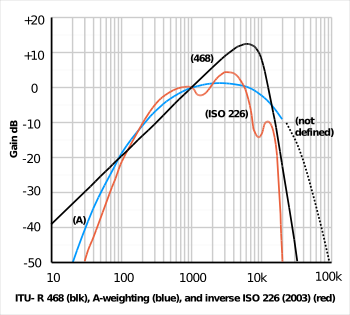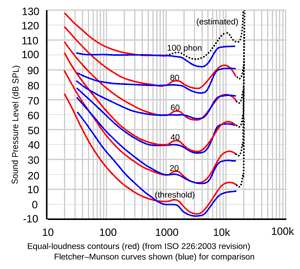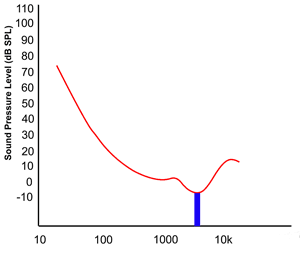Let's go back to Amir's article on the
"Audibility of small Distortions"
I have linked to research that shows the Fletcher-Munson threshold curve is not applicable to the perception of noise or clicks. Let me repeat the graph - we all love a good graph, don't we?


My reading of this graph is that we apply about +12dB of gain to noise around the 6Khz frequency & eyeballing the graph we apply about 5dB of gain to tones around the 2KHz frequency
Now, maybe Amir, Tony or someone can help with reconciling the two graphs into the same Y-axis - the above graph shows GAIN on the Y-axis whereas the Fletcher-Munson graph uses a Y-axis "sound pressure level" On the F-M graph the threshold at around 2KHz appears to be just about -10dB(sound pressure) & <5dB(gain) on 1st graph so how would the threshold for noise plot onto the F-M graph? Is it a multiplier 5dB gain becomes -10dB sound pressure - in which case we are talking about noise @ -24dB below the noise floor, a very significant sensitivity?

In Amir's article he quotes Dunn & Hawksford as having calculated that, based on the "Thresholds of audibility for tones" a level below 20 picoseconds of jitter is needed to guarantee it is below audibility - let's see another graph, hehe


The blue bar shows the level of jitter (20 picoseconds) below audibility.
Now given the above, it seems logical to revisit this jitter calc for noise as jitter & noise are interchangeable - jitter generates nosie & nosie, jitter.
Secondly, there is no masking concept for noise as there is with the sidebar distortion tones that are one of the distortions generated by jitter.
This was assumed in the article - "The distortion could very well become audible in the right circumstances. Put another way, just like our resonance situation, whether these distortions are audible is a matter of statistics."
So, my question is - what level of jitter is needed to fall below the audible threshold for noise shown in the first graph above?
What other sources of this low level noise will intrude on our auditory perception of music playback?
Have we really taken these aspects into consideration? Amir's article hasn't as he is only considering non-linear distortions resulting from jitter as spurious tones & analyses these in relation to F-M threshold of audibility & in relation to masking
And remember we don't perceive this noise as "audible noise" when it underlies music - it psychoacoustically affects the music in other perceptible ways
I'm trying to avoid the rut that some people steer this towards by opening up some discussion points which might be common ground




